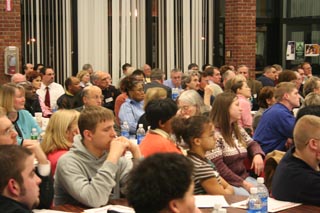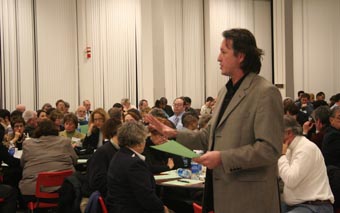| Included
in the kick-off event was a conversation about the attributes of
successful regional communities based on the experiences of success in
other parts of the world. Here is a summary of these attributes: |
| |
TOP TEN ATTRIBUTES OF SUCCESSFUL REGIONAL COMMUNITIES
|
| |
| 1. Evidence of strong
community pride and inclusive culture |
|
Successful
regional communities are often showplaces of care, attention, history and
heritage. They celebrate their success and have a strong and positive local
attitude and support a culture of risk taking and innovation. Diversity is
often celebrated and people are welcomed. |
2. Invest in the future – built to last! |
|
People
believe that something worth doing is worth doing right. In addition to the
brick-and-mortar investments, all decisions are made with an outlook on the
future. Expenditures are considered investments
in the future, including investments in people. |
|
| 3.
Participatory approach to community decision making |
|
Even
the most powerful of opinion leaders seem to work toward building consensus.
The stress is on groups, organizations and communities working together toward
a common goal. The focus is on positive results. People, groups and communities
collaborate and share resources. |
|
| 4.
Creatively build new economic opportunities |
|
Successful
regions and communities build on existing economic strengths in a realistic way;
and explore new economic opportunities provided by the ‘new economy’. They
actively seek out new opportunities and ideas for new businesses. |
|
| 5. Support
local businesses |
|
Local
loyalty is emphasized, but thriving regional communities know who their competitors
are and position themselves accordingly. |
|
| 6.
Deliberate transition of power to new leaders |
|
People under 40 regularly hold key positions
in civic and business affairs. Women (and people from ‘minority groups’) often
hold positions as elected officials, plant managers, and entrepreneurial
developers. |
|
| 7. Strong belief in and
support for education |
|
Good schools are the norm and
centers of community activity. |
|
| 8. Strong presence of
traditional institutions that are integral to community life |
|
Churches,
schools and service clubs are strong influences on community development and
social activities. |
|
| 9.
Willingness to seek help from the outside |
|
People seek
outside help for local needs, and many compete for government grants and
contracts for economic and social programs. They seek out the best ideas and
new people to help build their local community and regional strengths. |
|
| 10.
Communities and regions are self-reliant |
|
There is a
wide-held conviction that, in the long run, ‘You Have to Do It Yourself’.
Thriving regional communities believe their destiny is in their own hands.
Making their region a good place to live and work is a pro-active assignment,
and they willingly accept it. |
|



